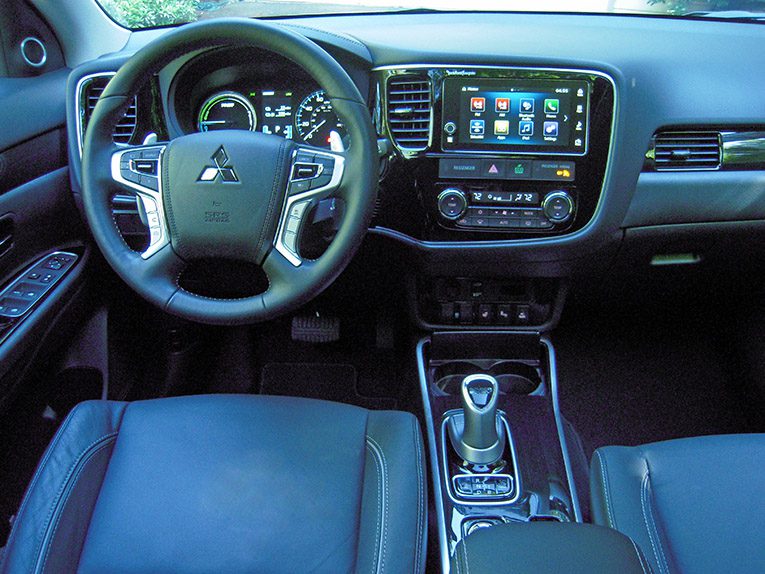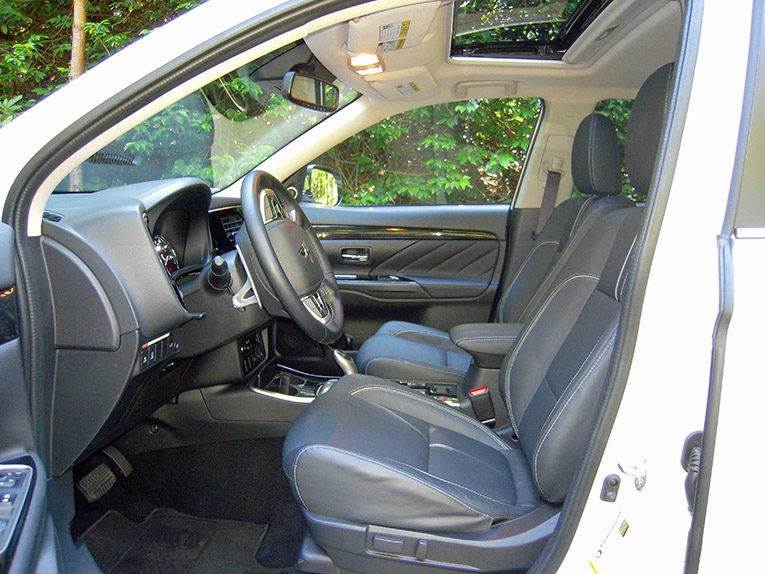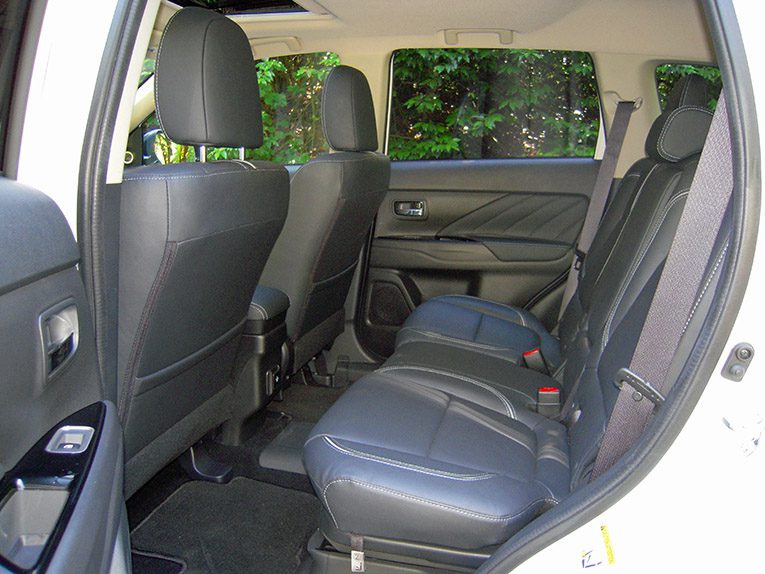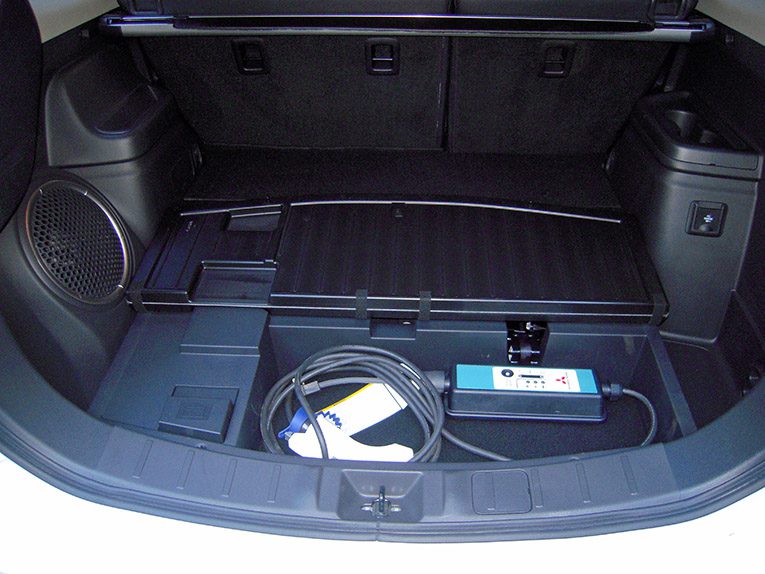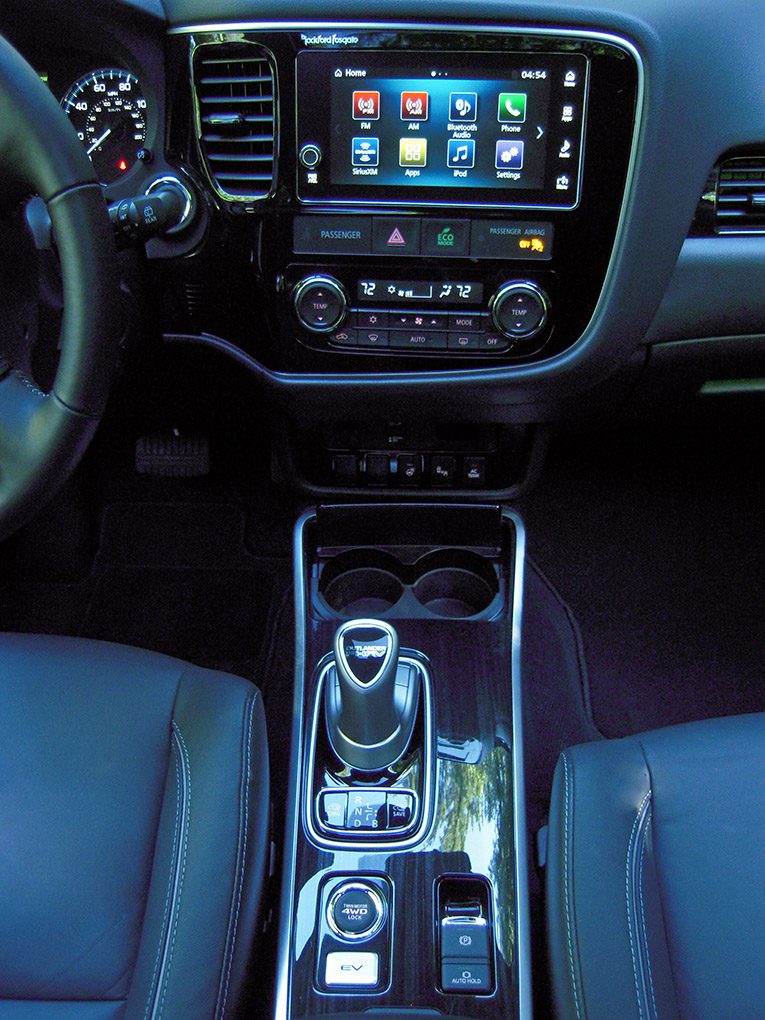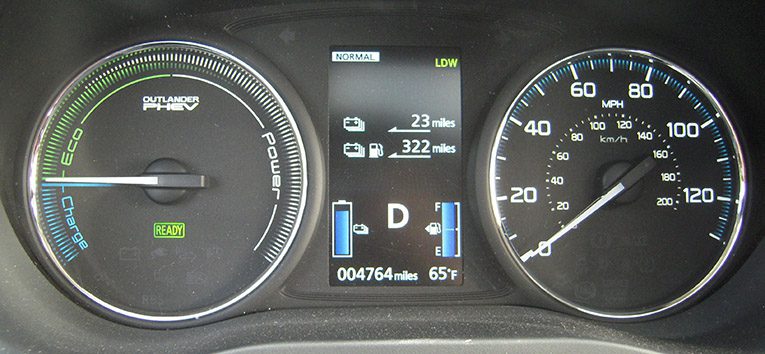Mitsubishi bills the Outlander PHEV as the world’s best-selling plug-in hybrid crossover. Now there aren’t exactly a ton of plug-in hybrid crossovers so it’s not too tough to be the best-selling vehicle in this category. But the Outlander PHEV still has a lot going for it especially for consumers who want an affordable and more environmentally-friendly vehicle. It offers EV power for everyday driving and gas to go further in the oh-so-popular crossover segment.
The PHEV is new to the Outlander line-up for 2018. It’s available in SEL and GT trims with starting prices of $34,595 and $40,295, respectively. The PHEV qualifies for a federal tax credit of $5,826. Mitsubishi’s S-AWC (Super-All Wheel Control) is standard. While the gas-powered Outlanders have three rows of seating, the PHEV has two and room for five passengers.
One look and you know the Outlander PHEV is a “greener” car, thanks to all of the graphics on the outside.
The Outlander PHEV has 22 miles of electric range. Factor in the 116-horsepower gas-powered engine and it has a total range of 310 miles. For many drivers, 22 miles is enough for daily driving. The gas engine gives you options for when you have longer drives or want to take the family on a road trip and don’t have time to recharge the electric battery along the way.
It’s powered by a 2.0-liter four-cylinder engine plus two 60-watt electric motors. One drives the front wheels and the other drives the rear wheels. It all adds up to 197 horsepower and 137 pound-feet of torque. The transition between electric and gas power happens very smoothly and is barely noticeable.
It’s pretty quick off the line, thanks to the single-speed transmission. Handling isn’t quite as lively at faster speeds, but it’s fine for everyday driving and excels in stop-and-go city traffic. While it’s not the most engaging driving experience, it’s a comfortable ride.
The Outlander PHEV has three drive system modes. EV Drive Mode is the most eco-friendly with energy provided by the lithium-ion battery pack. It’s 100 percent EV driving. The Series Hybrid Mode engages the gas-powered engine when the battery pack is low or when there’s a need for sudden and/or additional acceleration. Parallel Hybrid Mode basically uses the whole powertrain. The gas engine drives the front wheels, the two electric motors kick in when additional power is required, such as driving uphill, and the gas-powered engine feeds any extra energy back into the battery pack.
There are also three driver selected modes, Eco, Battery Save and Battery Charge, that let you tweak the drive settings in several ways to maximize use of all-electric power.
Eco mode reduces both fuel and electricity usage for increased efficiency. Battery Save Mode conserves the energy within the lithium-ion drive battery pack by operating the vehicle in hybrid mode. This mode will only operate once the battery pack’s energy level falls below 90 percent. You could set Battery Save Mode to drive on the freeway to maintain a higher level of battery charge; you could then deactivate the setting to drive in city stop and go traffic in EV drive mode. Battery Charge Mode generates energy from the gas-powered engine to charge the battery pack. This is the least efficient way to charge the battery, but it may make sense if you know you’ll be driving in city traffic later and want to use EV power then. It will replenish a low energy level within the battery back up to 80 percent charged in about 40 minutes. There’s also a Twin Power Off-Road mode for times when you’re off the beaten path.
The paddle shifters on the steering wheel adjust the level of regenerative braking instead of shifting gears. You can set this from B1, which provides little regenerative braking, to B5, which immediately slows the vehicle when you take your foot off the accelerator, allowing you to use one-pedal driving.
A smartphone app lets you communicate with the Outlander PHEV to manage charging, check the vehicle’s status and turn on climate control prior to your trip.
The interior is pleasant and controls are logically laid out. Seats are comfortable and adults in both rows of seating enjoy good leg- and headroom. Visibility is good all the way around.
Standard features in the Outlander PHEV include rearview camera, seven-inch touchscreen display, six-speaker audio system, two USB ports, Bluetooth, satellite radio, HD radio, Android Auto and Apple CarPlay. Standard driver assistance technologies include blind spot monitoring and rear cross traffic alert. No built-in navigation system is available.
The GT trim adds an eight-speaker audio system with subwoofer, adaptive cruise control, forward collision alert, automatic braking, lane departure warning and automatic high beams.
The Outlander PHEV is the world’s first plug-in hybrid electric vehicle with DC Fast Charging which will charge the battery up to 80-percent capacity in about 25 minutes. Of course, you can also use Level 1 and 2 charging. It takes about eight to 13 hours to fully charge the battery on a regular 120-volt plug.
The PHEV has 30.4 cubic feet of storage with both rows of seating in place and 78 cubes with the second row folded down. The 60/40 split-fold back seats provide flexibility in hauling passengers and cargo.
The warranty is worth mentioning. Mitsubishi has a five-year/60,000-mile limited warranty on the vehicle, as well as ten years or 100,000 miles on the powertrain, including the PHEV components and Lithium-ion drive battery.
The good:
It’s the only affordable AWD plug-in crossover
Standard all-wheel-drive
Pleasant interior
Android Auto and Apple CarPlay are standard
The not-so-good:
Limited all-electric range of 22 miles
Total range of only 310 miles
Pricing info:
My tester starts at $40,295. Diamond White Pearl paint is $200. Tonneau cover is $190. Body graphics are $285. Hood emblem is $85. Carpeted floor mats and portfolio are $135. Destination fee is $940 bringing the grand total to $42,130.
Bottom line:
Mitsubishi hits a home run with the Outlander PHEV as it fills the niche for an affordable AWD plug-in crossover. This vehicle makes sense for buyers looking to use less gasoline. The Outlander PHEV has the utility and practicality of an SUV, and 22 miles of all-electric range means many drivers can get by on a daily basis without having to use the gas engine. But the extra range is there when needed, as is all-wheel-drive capability.




